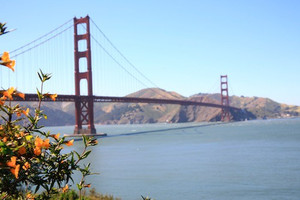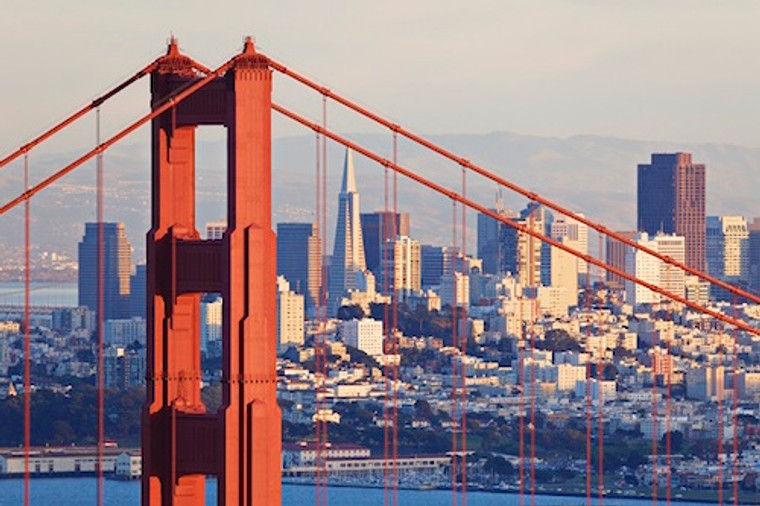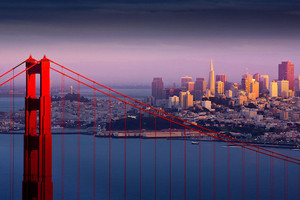
Driving for pleasure may be becoming a lost art in the modern world of freeways and deadlines, but cruising down California’s Pacific Coast Highway provides an escape into stunning landscapes and abundant wildlife. Especially when you do it in a red Mustang convertible.
PCH In A Nutshell
It’s just after 8pm and it’s approaching time for the nightly sunset show - we brake into another hairpin curve and drive into yet another surreal landscape as the first tinge of yellow permeates the horizon. With the Pacific Ocean as the backdrop, the show quickly moves into full swing. From yellow to orange, pink, red, blue, purple - and various outrageous hues in between - the multi-coloured palette moves through the sky and reflects off the water. It’s the end of a typical day of driving the Pacific Coast Highway in California - we pull over to a lookout to watch the show and down below the sea smashes into the rocks throwing plumes of water skyward.
California’s iconic Highway 1 has a well earned reputation for overwhelming the senses - and the stretch from San Francisco to Los Angeles features some of the most diverse and stunning scenery on the planet. Before we even started, we were told to follow two golden rules of driving the Pacific Coast Highway - or PCH to the locals. Rule number one: drive north to south as it puts the ocean and coastline literally on the passenger’s door. Rule number two: do it in a convertible to feel the full effects of nature and to allow a 360 degree view of all it has to offer.
South From San Fran
It is possible to drive San Fran to LA on the PCH in about eight hours with just a few brief stops on the way, but to fully appreciate this amazing coastline a journey time of at least three to four days is best. We’d planned a three night/four day road trip and within half an hour of negotiating San Francisco’s downtown one way system and freeways, we were on Highway 1 and heading towards the laid back towns of Pacifica and Half Moon Bay. With the trip less than an hour old, picture postcard moments present themselves at every turn, and experienced PCH devotees warned us this can cause serious scheduling problems. You simply can’t stop and take photographs every five minutes otherwise a four day trip could easily stretch into four weeks. Most people make the busy beach town of Santa Cruz, which is about 90km from San Francisco, their first overnight stop. With its boardwalk adorned with amusement rides and shops, it’s a popular weekend destination for Californians. As fun as Santa Cruz is, however, we’re aiming for Moss Landing a further 50 minutes or so down the highway. It’s a blink-and-you-miss-it kind of place and is often bypassed in favour of the tourist-friendly city of Monterey a little further down the track.
Moss Landing
Moss Landing is a one-street town built around its busy and protected harbour, and features a collection of restaurants and antiques shops. Here the pace of life kicks back a few gears and you get the impression most people in town are happy for the world to pass them by. Chill-factor aside, we were in Moss Landing to experience what’s been described as one of the most unforgettable wildlife experiences in the USA - the Elkhorn Slough Wildlife Reserve. Before we even leave the harbour we spot seals and sea lions basking in the sun on the marina decks and cormorants resting on platforms.
We’re still not even into Elkhorn Slough properly when a raft of around 30 rare sea otters paddle past us on their backs to catch the afternoon sun. There less than 3,000 of them left because of the fur trade in the past, and this sets the scene for a two-hour cruise where it seems the wildlife of Elkhorn Slough puts on a show just for us. We get close-up with an otter cub and its mother who are feeding, and another older otter who’s fending off the attentions of a seagull trying to steal his clam. As we head back from our experience which could have been straight out of a National Geographic documentary, curious harbour seals swim toward us and appear to regard our expedition with some amusement.
Monterey And Carmel
Moss Landing is a difficult place to leave behind, but ahead of us is some of the most stunning coastal scenery in the world, and within half an hour we’ve passed through Monterey at the start of the famous 17 Mile Drive. It’s a section of coast road that hugs the ocean and winds its way through cypress forests and some of the best golf courses in the world, including Pebble Beach Golf Links. The Lone Cypress is the highlight of this stretch and is one of California’s most enduring and photographed landmarks; it’s prevailed on its rocky perch for 250 years.
The charming town of Carmel marks the end of the 17 Mile Drive, and also signifies the beginning of the rugged and wild Big Sur coast. It’s a quirky place with a pretty white sand beach which is great for swimming and surfing, and a compact village centre with some interesting nooks and crannies to investigate its art galleries and restaurants. Carmel is worth a couple of days on its own and is just one of the endless distractions and side-trips that make for difficult decision-making on the PCH run.
Big Sur
We push on seven kilometres south to the iconic Highlands Inn, and with its panoramic views, it’s the perfect prelude to perhaps the highlight of California’s west coast - Big Sur. It’s been often compared to sections of the Mediterranean and even Scotland. But as author and the region’s most famous resident, Henry Miller, wrote: “Comparisons are vain. This is the face of the earth as the Creator intended it to look.” The section of road itself was literally blasted out of the sheer mountain side in the 1930’s, and driving it on the right hand side of the road is an awe-inspiring, and at times, hair-raising experience.
The mountains themselves appear to drop straight into the ocean and hairpin curves and tight corners are negotiated several hundred metres above the sea and rocks below, adding to the sheer drama of the landscape itself which looks like the set of an epic movie. And just when you think you’re done gawping and snapping for the day, the Piedras Blancas Elephant Seal Colony provides yet another unrivalled wildlife experience, just before San Simeon. We arrive in mating season, perhaps the most interesting time on the beach, with rival males sizing each other up and fighting for supremacy and the right to choose a female.
End Of The Road
As fascinating as the seal colony is, we’re aiming for the laid-back beach town of Pismo to catch another sunset, and the idea of being surrounded by the sound of the ocean for our last night of the journey is distinctly appealing. As the sun drops over Pismo Pier, the local life embraces the sheer beauty of a west coast sunset - surfers, joggers, dog walkers, horse riders all marvel at nature’s light show even though they’ve probably seen it thousands of times. The next day, LA will be the final driving leg, but if this trip were a movie, it feels now would be the appropriate time to roll the credits.
- By:
- Ben Hall
















